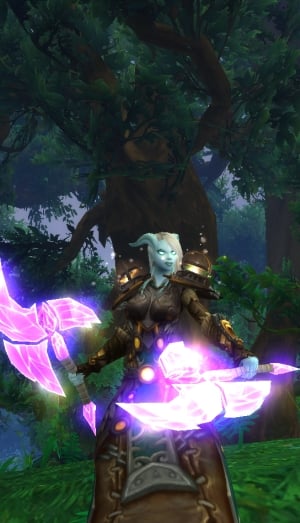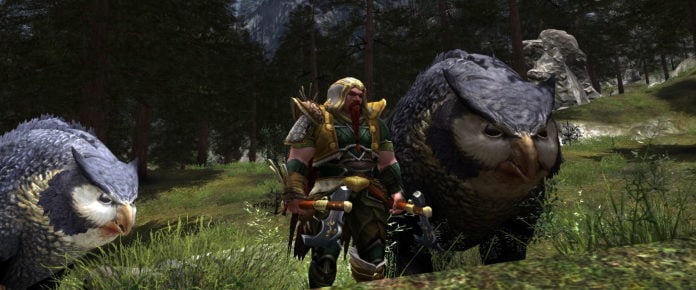
Back in May, I wrote a whole article about why I was leaving World of Warcraft behind. All of the reasons I had back then? Still valid. Fact is, I’m still proud of that column (to the extent that I’m proud of anything I write; low self-esteem is a hell of a drug). So why am I here talking so much about Battle for Azeroth? How are you supposed to reconcile those conflicting facts? Do I hate this game or not?
The answer to those questions, in reverse order, is this: no; I highly doubt anyone actually wants to reconcile anything about my stated views; and because what we’ve seen so far actually addresses a lot of the problems I wrote about back in May. New information means new evaluation.
Obviously, this is not a blanket statement of “the next expansion will make everything better” because there are far too many question marks left to feel smug or confident about that. But, and this is an important “but,” we’ve got signs that several of the problems from Legion are actually being addressed. And considering that Legion was pretty good already, that brings us to a good spot.
Random soup
 One of the big problems with Legion, as I’ve mentioned before, was that the dang thing was shot through with randomness from top to bottom. Randomness existing is fine; it’s the fact that random drops could literally make the difference between “playable” and “crap” depending on your luck with Legendaries. That is an enormous damn problem, and it’s something that should never have gotten to this point.
One of the big problems with Legion, as I’ve mentioned before, was that the dang thing was shot through with randomness from top to bottom. Randomness existing is fine; it’s the fact that random drops could literally make the difference between “playable” and “crap” depending on your luck with Legendaries. That is an enormous damn problem, and it’s something that should never have gotten to this point.
It may, in fact, be the biggest problem that Legion had. And it’s something we know right away won’t be coming back in Battle for Azeroth because the designers have outright said that Legendaries are being banished to the land of wind and ghosts.
Yes, the whole Heart of Azeroth structure resembles making your own Legendary equipment for certain spots, but seeing as how those items both cannot be Titanforged and can be reliably gotten, it eliminates the central problem. You won’t wind up feeling like the thing that you really need has not shown up in the countless places it could possibly and randomly show up, nor are you going to be saddled (hopefully) with abilities that have no positive impact on your character whatsoever.
We don’t know about the other rewards, although I’ve got hopes that they may turn out to be less of a randomized mess. But even just removing one of the game’s major “slay and pray” elements puts more control in the hands of the players. It’s a huge structural problem actually being addressed, which seems as if it’s been absent from the game’s design for a long while; there’s been a tendency to listen to the few people who win from a system instead of the many who lose.
Top-heavy grind-heavy
Artifacts ran into another problem insofar as you were, honestly, not in a fun spot once you got to the top end. Get more Knowledge, boost up your AP gains even more, stack insane number of traits… you get the idea. The whole thing was beyond messy, and it seemed to change from “level up your weapon alongside your gameplay” to “level forever.” Plus, in a serious ding to its actual playability, there were no sorts of caps to observe; more Artifact levels were always out there, and more levels were always what you wanted.
The Heart of Azeroth provides more power as it levels, yes, but it’s set up to have a very different progress structure that isn’t purely about “get more.” Once you’ve unlocked all of the traits on your armor, well, further levels are just banked insurance, not something you need to claw for religiously. While the system might not have some of the fun of getting trillions of points at a go, it ultimately isn’t as clumsy as artifacts turned out to be.
Of course, as I mentioned in the comments the other day, that’s not how artifacts needed to be… but it’s how they were. It’s a moot discussion now.

Reward structures
This one gets the most into speculation territory; there are a lot of reward structures we just plain don’t know about yet. I think the odds of actually getting away from the whole “bonus roll” system are fairly low, much as I’d like to, but there’s also space to imagine that some new content might have different reward structures. And while Titanforging isn’t going away, the sheer insipid nature of the hunt for Legendaries is going away.
I’m not going to say that this is going to wildly fix Legion’s reward issues, considering how much the current designers love letting you hope for gear you want. But it does seem as if a lot of tweaks are being made to the system to make things feel less obnoxious, and there’s spots for hope.
Differentiation
One of the problems that Legion had on a structural level is that – and I say this at the risk of being pedantic – there was nothing new to be seen on a new character. The level scaling meant that you could tackle the continent however you wanted… if you ignored the fact that most of your early quests probably didn’t start in Stormheim, anyhow. But more importantly, by the time you reached level 110, you had more than likely seen all of the existing zones, and any new character was going to be doing the same thing, regardless of faction. There were a handful of factional quests and that was it.
Battle for Azeroth makes that better right out of the gate by ensuring that both factions get their own storylines, even more so as you realize that scaling is spreading through the whole world and gives you more options about what to explore. It’ll probably spread into a muddled mass at a certain point, yes, but the important element is that you have a larger pool of new stuff to see. Not an endless font of it (that’s impossible), but more.
“People just leave”
Ah, now we hit the crux of the matter, the comment that really just set me off in my May article. It was this idea out of Blizzard that understanding why people leave wasn’t important – the studio’s apparent conviction that a high rate of attrition was inevitable and should be handled with a shrug and a glance to the audience in confusion. This was the part that bothered me the most, coupled with boneheaded decisions that made it painfully clear why people left.
Unfortunately, Ion Hazzikostas is still there, so that’s not a great sign that something has changed. But the changes on prior points and the overall tenor says, at least to me, that if asked the same question, he might not say the same thing again – that somewhere, something clicked, an idea that perhaps “why people leave” is a problem to be addressed even if can’t be completely solved.
It seems to me that a change took place somewhere along the line, maybe even after those incredibly dumb words were spoken. And it feels, at least to me, as if someone’s gone back to giving a damn. Not that the work wasn’t being put in before (there’s a difference), but that there’s something more driving the expansion here.
I’ve spent the past week writing about the expansion, clarifying points that were there but weren’t really explained clearly, surveying reasons why this is the game’s next expansion. And the thing is that projects where that’s not usually clear tend to come about for a reason. You’re usually looking at someone’s passion project, something that someone wants to exist even if no one else gets why it’s important.
Explaining a passion project is hard to do because it’s important to you and you know it’s going to connect with people. If Warlords of Draenor was an appeal to the past and Legion was throwing all the obvious crowd-pleasers together, Battle for Azeroth looks like a time when the team is willing to try ideas that, on their face, might have a hard time connecting with players.
And yeah, it might be crap. It could, in fact, be in the Cataclysm tier of expansions. But at least it’s going to be trying some weird and new things along the way. That’s worth points for effort, and that’s enough for me to say, “Yes, these things are finally being addressed” enough for me to return.
 War never changes, but World of Warcraft does, with a decade of history and a huge footprint in the MMORPG industry. Join Eliot Lefebvre each week for a new installment of WoW Factor as he examines the enormous MMO, how it interacts with the larger world of online gaming, and what’s new in the worlds of Azeroth and Draenor.
War never changes, but World of Warcraft does, with a decade of history and a huge footprint in the MMORPG industry. Join Eliot Lefebvre each week for a new installment of WoW Factor as he examines the enormous MMO, how it interacts with the larger world of online gaming, and what’s new in the worlds of Azeroth and Draenor.















